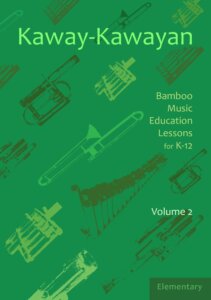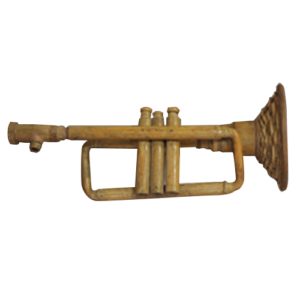Elementary Module
BAMBOO MUSICAL INSTRUMENTS OF BAGOBO-TAGABAWA IN DAVAO
- Volume 2
Background

Excerpt from the BMI Ethnography of Bagobo-Tagabawa of Toril, Davao
“Pangdawet: Bagobo-Tagabawa Bamboo Music Instruments” By Yves P. Cuenza
The term “Bagobo” is a collective terminology that is being used among the Indigenous Cultural Communities/Indigenous Peoples (ICCs / IPs) of Southern Mindanao. This quasi ethnographic and instrumentation output will focus on bamboo musical instruments among the Bagobo-Tagabawa. “Tagabawa” is the name of a specific ethnic group that resides in both the flat plains and mountainous areas of Southern Davao. Their ethnic group name is derived from the word “Bawa” which means “the south.”1 Hence, they consider themselves the Bagobos of the south, more than the collective naming as simply “Bagobos” of Davao. Laura Watson Benedict was able to describe them in her article about this indigenous community, “. . .one of the groups of pagan Malays in southeastern Mindanao, Philippine Islands. Their habitat is on the eastern folds of the Cabadangan mountain-range, in the vicinity of Mount Apo, the highest peak, and on the foothills peak, and on the foothills then sloping down to the west coast of the Gulf of Davao.”2 This ethnographic project will primarily focus on the bamboo musical instruments of the Tagabawa people. They call it “pangdawet,” the term for music instruments in their own language. One of the most important contexts in understanding the music of indigenous Philippine music is to know how it functions with the society outside their community and how they interact with it. Tejero explained that:
The music of the cultural groups is tied closely to their community life. Music to them is not for entertainment. Rather, music has functions that are meaningful and indispensable to the tribes. The vocal and instrumental genres are identified according to their functions, which are usually connected with activities of the life cycle, agriculture, peace-pact making and curing of the sick.
The Bamboo Musical Instruments
|
Photo |
Instrument |
Method of Sound Production |
Melodic range |
Role in the Ensemble |
Function in Ritual or Social / Cultural Activity |
 |
Togo, 8 string (small bamboo zither) |
plucked |
A4 to C5 |
individually played |
festivals and rituals |
 |
Ommo, aerophone |
blown |
bird sound imitation |
individually played |
hunting, identi- fication of bird sounds for local knowledge |
 |
Assa- Assa Kagik Manok |
blown |
bird sound imitation |
individually played |
hunting, identi- fication of bird sounds for local knowledge |
|
Photo |
Instrument |
Method of Sound Production |
Melodic range |
Role in the Ensemble |
Function in Ritual or Social / Cultural Activity |
 |
Palakpak ka Odok, idiophone |
shaken |
NA (rattle percussion) |
individually played |
Used for time keeping during rice planting and harvest |
 |
Kombeng, lamella- phone (jaws harp) |
plucked idiophones |
Mainly F2 and would resonate down to Eb2 |
individually played |
religious rituals, courtship, communication |
 |
Lantoy, aerophone |
edge blown |
D4 to D5 |
individually played |
self-expression and entertainment |
A. Content Standards
Demonstrate understanding of the concept of timbre and rhythm through performances, listening, and improvisation.
B. Performance Standards
- Differentiate the sources of sound from a single
- Create rhythmic improvisations based on active listening
- Perform solo or with a group with different rhythmic patterns per
C. Learning Competencies/Objectives
- Identify the source of sound made using the voice, body, and instruments
- Replicate sound heard from different
- Improvise using the bamboo percussion instruments or improvised percussion instruments
A. Timbre – variations of sound using the voice, body, and instruments
B. Rhythm – understanding rhythm through listening
A. References
- Print Materials
a. BMI ethnography on Bagobo-Tagabawa in Davao
b. BMI documentation pictures of the Bagobo-Tagabawa people and bamboo instruments
- Audio-Video Materials
a. Videos from the BMI documentation

b. Video of a Bagobo dance with agung
c. Video of a Bagobo-Tagabawa youth dance
d. Video of a gong music from Bagobo-Tagabawa
e. Video of a Bagobo-Tagabawa household
B. Other Learning Materials
- Available bamboo musical instruments from the Bagobo-Tagabawa ethnolinguistic group
- Improvised percussion instruments:
-Shaker (plastic bottle or empty toilet paper rolls with uncooked rice or mung beans)
-Drum (empty large tin cans) or any large plastic container
A. Reviewing the previous lesson or presenting the new lesson
- Play the video of the Bagobo-Tagabawa youth dance and ask the students if they have a similar activity where they dance together
- Show a picture of the community of the Bagobo-Tagabawa ethnolinguistic group and ask students to describe what they see. Ask questions like: what geometric designs are put on their garments, what are the colors used in the garment, and what do you think is the fabric made of?
B. Establishing the purpose of the lesson
- Play the video of the Bagobo-Tagabawa household and ask students what the different objects they saw in the video were. Ask if they keep objects made of bamboo
- Show a picture of a bamboo and ask students to enumerate objects or furniture found at home that are made of
- Ask the students if they ever held a musical instrument made of bamboo and how it is
C. Presenting examples/instances of the new lesson
-
- Watch the videos by the masters playing their bamboo instruments (from Bagobo-Tagabawa BMI) and ask students what the instruments sound like
- After playing the different sounds of instruments and naming them, ask the students to listen to the samples again and identify what instrument is played without looking at the video.
D. Discussing new concepts and practicing new skills 1
-
- Define and discuss timbre and how an instrument or the voice produces a different sound
- Play an instrument while the students’ eyes are closed. Let them identify what type of instrument is playing
- Watch the Bagobo-Tagabawa video (dance with agung) and tell students that music can accompany dance
- Let them differentiate the sounds of bamboo musical instruments and gongs ask what they can picture whenever they hear a certain sound
E. Discussing new concepts and practicing new skills 2
-
- Clap simple rhythmic patterns and ask the students to imitate the patterns(call and response).
- Group the students into pairs and assign them their own rhythmic pattern. The teacher will do a steady beat while the students clap their own pattern.
- Assign a bamboo or any available percussive instrument to the students and let them play their patterns with the instruments.
- Do a steady beat and ask students to play their instruments by group, only entering after a group has made their pattern and repeating it until the teacher signals to stop.
F. Developing mastery (leads for formative assessment)
-
- Assign syllables to represent the rhythmic pattern below and make students listen and repeat after you orally first.

-
- Assign rhythmic patterns orally to each group playing it on their own instrument
- Make the students create their own patterns orally and translate it to playing their instruments after practicing it
- Make the group play together
- Assess the students’ performance using teacher-made rubrics
G. Finding practical applications of concepts and skills in daily living
- Students are made to realize the usefulness in identifying people, instruments, and objects by the sound that they produce
- Students find importance in developing the art of listening and camaraderie in a group.
H. Making generalization and abstraction about the lesson
Objects such as bamboo, rocks, and sticks found in our surroundings can be seen as ordinary, but these objects can actually be made into something useful such as transforming it as a musical instrument. Ethnolinguistic groups like the Bagobo-Tagabawa use musical instruments made of bamboo, which are played during festivities or gatherings. Transforming common objects like the bamboo into something inventive or useful shows creativity and cultural awareness of one’s environment.
I. Additional activities for application or remediation
Create more challenging patterns through oral transmission and let the students have fun in improvising rhythmic patterns.
A.How many learners earned 80 percent in the evaluation? How many learners require additional activities for remediation?
B. Did the remedial lesson work? How many learners have caught up with the lesson? How many learners continue to require remediation?
C. Which of my teaching strategies worked well? Why did this work?
D. What difficulties can my principal or head teacher help me solve?
E. What innovation or localized materials did I use/discover which I wish to share with other teachers?
Science in a creative industry.
The DOST-FPRDI has a Bamboo Musical Instruments Innovation R&D program aimed at improving the quality of locally-made bamboo musical instruments (BMIs) through science and innovative technologies. The program seeks to standardize the production of selected BMIs, develop prototype designs, analyze raw material sources and existing markets, and build a BMI processing facility. In addition, the program aims to document the ethnocultural story behind several BMIs and identify the bamboo species used in BMI production to promote public awareness and appreciation of the cultural importance of these musical instruments. The program is a collaboration with the University of the Philippines and Philippine Normal University for teaching modules and analyzing sound quality and standardization of BMI design. The DOST Grants-in-Aid program provides funding.
PhBMI

